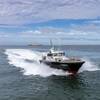Is it the Answer? Hybrid Marine Propulsion
Soaring energy costs, more stringent emission regulations and conservation efforts are current topics in every media outlet. With crude oil prices around $120 per barrel, the question arises — what should the U.S. shipbuilding industry do to address those issues to its customers?
Only a few years ago, consumption and efficiency were just two of many criteria when it came to the design of a new vessel. Today, however, they have great importance when a new design is on the drawing board.
Before we answer the above questions, let's define the status quo. The vast majority of vessels built worldwide are outfitted with diesel propulsion and conventional shaft line.
This method of propulsion for long haul trade has been proven over many years as the most efficient and cost-optimized solution. Naval architects, shipyards and equipment suppliers improved the design and equipment to optimize fuel efficiency and reduce emissions. Better fuel efficiency has been achieved using innovative design including optimized hull, variable pitch propellers, coated propellers, bulbous bows, stern flaps and other ship-related features.
Environmental measures introduced by regulatory bodies and legislation triggered an avalanche of innovation on the engine side such as common rail, direct injection, alternative fuels that satisfy the requirement for the reduction of sulfur dioxide, nitrogen oxides and carbon emissions. Parallel to the reduction of emissions, engine manufacturers also optimized specific fuel consumption.
All these measures present an optimization of an existing propulsion system. Most certainly, we will see more innovation for these existing solutions in the future.
Rising Fuel Prices
The U.S. shipbuilding industry is mainly involved in short haul transportation, inland transportation, ferries and offshore vessels. The criteria previously mentioned are transferable to this type of transportation; however, they do not provide the same improvements due to the short haul mission profile with changing load demands and more idle time. Starting in the late 80s and early 90s, European operators and shipyards began to apply diesel electric propulsion systems on a broader basis for this kind of vessel.
Higher investment costs, more equipment, higher weight and losses in power conversion make a diesel electric solution initially appear unattractive. The emergence of diesel electric propulsion presents the U.S. shipbuilding industry the challenge to integrate a complete new propulsion concept into the design of vessel, combined with higher investment cost.
Manufacturers of electrical equipment convinced naval architects, shipyards and ship owners of the merits of diesel electric propulsion and supported the integration into vessels.
Today, we have seen that diesel electric propulsion provides significant fuel savings on ferry boats or offshore supply vessels. U.S. shipbuilders have mastered this challenge, and major offshore vessel programs are today equipped with a diesel electric propulsion concept.
Is hybrid the next phase?
As a result of their excellent fuel economy, hybrid vehicles are enjoying an increasing popularity on U.S. highways. The marine industry adopted hybrid solutions much earlier in the form of shaft generators and booster drives.
Recently tug operators have made efforts to integrate hybrid solutions into tugboats. Hybrid tugs will be powered by a combination of diesel generators and batteries. Conventional harbor tugs are exposed to a rapidly changing mission or load profile, which presents an optimal application for hybrid propulsion.
Shipyards and equipment suppliers face unprecedented challenges to master this next
phase of propulsion evolution. A typical tugboat is in the 60'-90' range, and today's diesel propulsion solutions occupy large areas of the engine room. Designers and shipyards carefully consider equipment placement and, in many cases, an additional piece of desired equipment cannot be installed due to a size issue.
The engine room of a hybrid tug needs to accommodate even more equipment, including generators, batteries, electric drives and electric motors. Switchboards, generators and power management have a proven design and are readily available in the market. Suppliers will be required to further optimize the footprint of those. Equipment supplier like Siemens Energy & Automation, Inc. addressed this by designing smaller footprint equipment.
Design and Physical size of Batteries, Electric Drives and Motors
Battery technology is changing rapidly. Na NiCl2, NiMh, or lithium-ion batteries show very promising results that seem applicable to hybrid tugs. Manufacturers of electrical drives have greatly reduced equipment sizes with state-of-the-art power IGBT switching modules and optimized switching frequencies, reducing losses. Electrical propulsion motors are available in water jacket cooled designs or as permanently excited machines.
Another major challenge is the integration of electrical drives and batteries. The fluctuating battery voltage combined with the constant voltage of the generators requires a close cooperation between the battery supplier and drives. Siemens Energy & Automation, Inc responded with Active Front End solutions or Smart Line Front End to address this technical issue.
The market potential for "green tugs" is excellent. The technical challenges appear manageable, and with every hike in the oil price, the solution becomes more viable from a commercial standpoint.
Thomas Orberger is Account Manager and Development manager for Industrial Large Drives for Marine and Offshore applications at Siemens Energy & Automation in Alpharetta. He has a degree in electrical systems engineering from the University of Applied Science in Kiel, Germany, and has a 13-year background in electrical marine engineering.
Email: [email protected]
(Reprinted from the September edition of Maritime Reporter)












